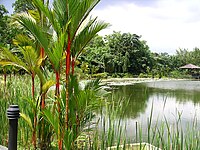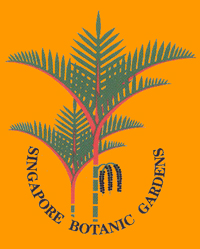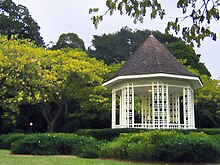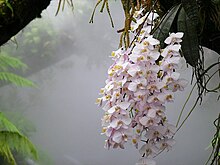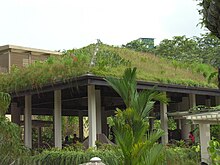
The National Botanic Gardens is a botanical garden in Glasnevin, 5 km north-west of Dublin city centre, Ireland. The 19.5 hectares are situated between Glasnevin Cemetery and the River Tolka where it forms part of the river's floodplain.

A botanical garden or botanic garden is a garden with a documented collection of living plants for the purpose of scientific research, conservation, display, and education. It is their mandate as a botanical garden that plants are labelled with their botanical names. It may contain specialist plant collections such as cacti and other succulent plants, herb gardens, plants from particular parts of the world, and so on; there may be glasshouses or shadehouses, again with special collections such as tropical plants, alpine plants, or other exotic plants that don't grow natively within that region.

Vanda, abbreviated in the horticultural trade as V., is a genus in the orchid family, Orchidaceae. There are 90 species, and the genus is commonly cultivated for the marketplace. This genus and its allies are considered to be among the most specifically adapted of all orchids within the Orchidaceae. The genus is highly prized in horticulture for its showy, fragrant, long-lasting, and intensely colorful flowers. Vanda species are widespread across East Asia, Southeast Asia, and New Guinea, with a few species extending into Queensland and some of the islands of the western Pacific.

Dendrobium is a genus of mostly epiphytic and lithophytic orchids in the family Orchidaceae. It is a very large genus, containing more than 1,800 species that are found in diverse habitats throughout much of south, east and southeast Asia, including China, Japan, India, the Philippines, Indonesia, Australia, New Guinea, Vietnam and many of the islands of the Pacific. Orchids in this genus have roots that creep over the surface of trees or rocks, rarely having their roots in soil. Up to six leaves develop in a tuft at the tip of a shoot and from one to a large number of flowers are arranged along an unbranched flowering stem. Several attempts have been made to separate Dendrobium into smaller genera, but most have not been accepted by the World Checklist of Selected Plant Families.

The Birmingham Botanical Gardens are a 15-acre (6-hectare) botanical garden situated in Edgbaston, Birmingham, England. The gardens are located 1+1⁄2 miles (2.4 km) south-west of Birmingham city centre at grid reference SP049854. Designed in 1829, the gardens are Grade II* listed in Historic Englands's Register of Parks and Gardens, and retain many original features and layout, which was designed by the landscape gardener and horticulturalist John Claudius Loudon. The site is notable for its range of glasshouses and gardens, which display a wide variety of plants and birds. Birmingham Botanical Gardens is managed by Birmingham Botanical and Horticultural Society, a registered charity. The gardens are open daily to the public with paid admission.

Henry Nicholas Ridley CMG (1911), MA (Oxon), FRS, FLS, F.R.H.S. was an English botanist, geologist and naturalist who lived much of his life in Singapore. He was instrumental in promoting rubber trees in the Malay Peninsula and, for the fervour with which he pursued it, came to be known as "Mad Ridley".

The Bogor Botanical Gardens is a botanical garden located in Bogor, Indonesia, 60 km south of central Jakarta. It is currently operated by the National Research and Innovation Agency. The garden is located in the city center and adjoin the presidential palace compound of Istana Bogor. It covers an area of 87 hectares and contains 13,983 different kinds of trees and plants of various origin. The geographic position of Bogor means it rains almost daily, even in the dry season. This makes the garden an advantageous location for the cultivation of tropical plants.

Singapore has a wide variety of flora. Plants are mainly used to beautify the landscape of Singapore. The national flower is a hybrid orchid, Vanda Miss Joaquim.

The Penang Botanic Gardens is a botanical garden within the city of George Town in the Malaysian state of Penang. Situated at Jalan Air Terjun, it is also colloquially known as the Waterfall Gardens because of the cascading waterfall nearby.
Charles Curtis was an English botanist who was sent by James Veitch & Sons to search for new plant species in Madagascar, Borneo, Sumatra, Java and the Moluccas, before settling in Penang, where he became the first superintendent of the Penang Botanic Gardens.

Isaac Henry Burkill was an English botanist who worked in India and in the Straits Settlements. He worked primarily in economic botany but published extensively on plant biology, ethno-botany, insect-plant interactions and described several species. He published a two volume compilation on the plants of economic importance in the Malay Peninsula, collating local names and knowledge. He also wrote a detailed history of botany in India. The plant genera Burkillia and Burkillianthus were named in his honour.
Richard Eric Holttum was an English botanist and writer.

The Botanischer Garten München-Nymphenburg is a botanical garden and arboretum in Munich, Germany.

Dendrobium bigibbum, commonly known as the Cooktown orchid or mauve butterfly orchid, is an epiphytic or lithophytic orchid in the family Orchidaceae. It has cylindrical pseudobulbs, each with between three and five green or purplish leaves and arching flowering stems with up to twenty, usually lilac-purple flowers. It occurs in tropical North Queensland, Australia and New Guinea.

Spathoglottis plicata, commonly known as the Philippine ground orchid, or large purple orchid is an evergreen, terrestrial plant with crowded pseudobulbs, three or four large, pleated leaves and up to forty resupinate, pink to purple flowers. It is found from tropical and subtropical Asia to Australia and the western Pacific including Tonga and Samoa.

Papilionanthe Miss Joaquim, also known as the Singapore orchid, the Princess Aloha orchid and formerly as Vanda Miss Joaquim, is a hybrid orchid that is the national flower of Singapore. For its resilience and year-round blooming quality, it was chosen on 15 April 1981 to represent Singapore's uniqueness and hybrid culture.
Alex Drum Hawkes (1927–1977) was an American botanist and cookbook author who lived in Coconut Grove, Florida & Kingston, Jamaica. Alex specialized in orchids, bromeliads, palm trees, fruits, vegetables, and nuts. Named the orchid genera Flickingeria, and Paraphalaenopsis and travelled the world extensively, particularly the Caribbean & Latin America during the 1940s - 1970s collecting plants and authentic regional recipes.
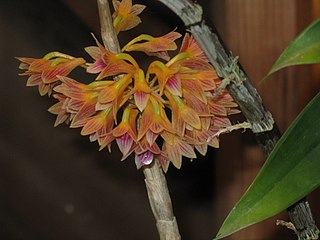
Dendrobium × usitae, or Usita's dendrobium, is a species of epiphytic orchid endemic to the Philippines. It is a natural hybrid between D. bullenianum and D. goldschmidtianum and can be easily distinguished from both species by its purplish orange flower. The specific epithet honors Villamor T. Usita of Quezon City, who discovered the species from Calayan, one of the five major islands of Babuyan archipelago. In its native habitat, the plant grows hanging on trees at an elevation of 500 to 700 meters above sea level alongside its parent species. The pendulous stem of D. × usitae can reach a length of 60 centimeters.
Dendrobium convexum, commonly known as the piggyback orchid, is an epiphytic orchid in the family Orchidaceae. It has a creeping, brittle root, erect pseudobulbs with a single leaf on the top and one or two cream-coloured, short-lived flowers with a red and yellow labellum. It is native to Southeast Asia, New Guinea and tropical North Queensland, Australia.
Humphrey Morrison Burkill OBE, was a director of the Singapore Botanic Gardens from 1957 to 1969.

